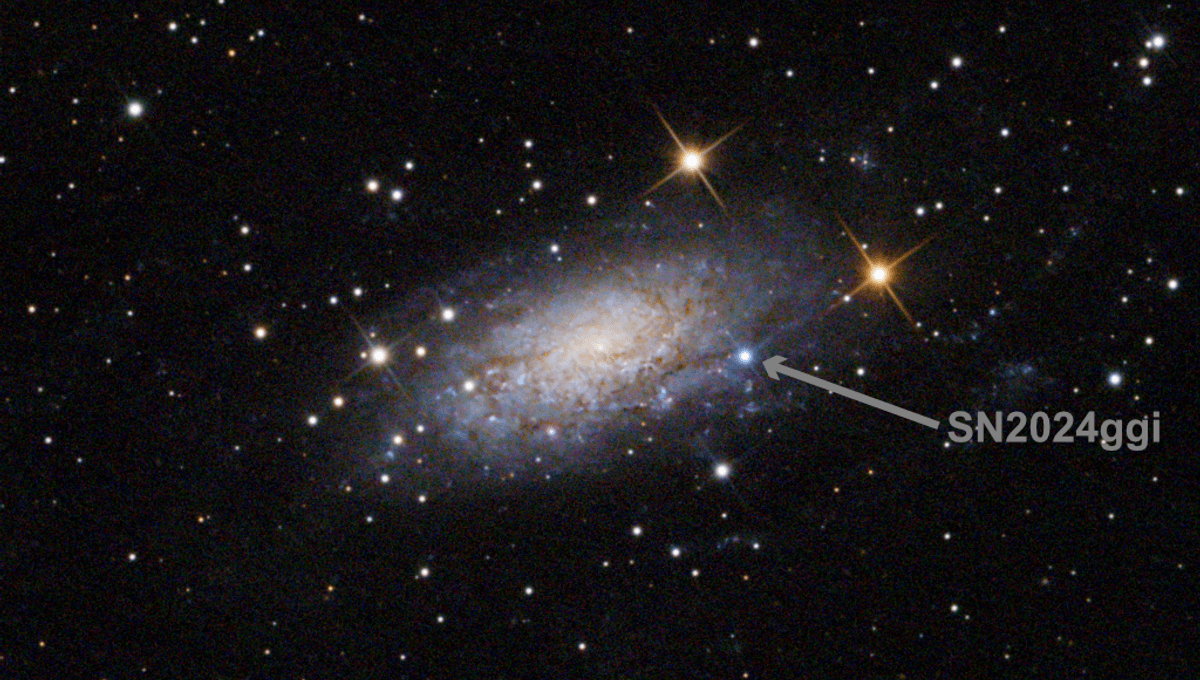
Less than a year after the discovery of one of the closest supernovae of the century, another has popped up only slightly further away. So far, no professional images of the exploding star have been released, but amateurs are filling the gap, although many live too far north to be able to participate.
Since the invention of the telescope there has not been a supernova explosion in our galaxy (with a possibility of some hidden by dust clouds). Expanding to our local group of galaxies adds just one in astronomers’ lifetime: 1987a. That’s frustrating, because these are some of the most exciting and scientifically useful events in astronomy, and a galaxy the size of the Milky Way should average one a century.
That puts even more emphasis on the next ring out of galaxies beyond the local group, where there have been five this century at 22 million light-years away or closer. The latest of these, named SN 2024ggi, was first spotted on April 11 and may still be getting brighter.
The most recent previous nearby supernova, 2023ixf, was visible with small telescopes last year. It had the advantage of being in the Pinwheel galaxy, a favorite target for amateur astronomers at any time.
SN 2024ggi lies in the NGC 3621, which is not quite as spectacular, mainly because we see it nearly edge on. Nevertheless, it’s still an impressive sight if you have a good enough telescope. Officially NGC 3621 is 22 million light-years away, a million more than the Pinwheel, but there is enough uncertainty in these measurements that it’s possible its slightly closer. The two are in almost opposite directions, with the Pinwheel being so far to the north that it never sets from Europe and most of North America. On the other hand, NGC 3621 is at 33 degrees south – almost impossible to see from Britain, and it’s visible only fairly briefly from most of the United States.
A star’s brightness is measured in magnitude, with magnitudes 5 and below visible to the naked eye under dark skies, while higher magnitudes are progressively fainter.
The new discovery was made by ATLAS (the Asteroid Terrestrial-impact Last Alert System). Besides its prime job to look for nearby space rocks, ATLAS now finds more supernovae using four telescopes on three continents than any other sky survey. At detection, SN 2024ggi was about 19th magnitude, requiring an unusually large telescope by the standards of backyard astronomers.
That’s not exceptional; this year alone there have been dozens of supernovae recorded at 16th or 17th magnitude, but very few that got brighter than that, simply because they were too far away. 2023ixf was spotted at a similar brightness, but brightened more than a hundred-fold to peak at 10.9. Almost a year later, it’s down to 17th magnitude.
Official records show 2024ggi increasing to 14th magnitude, but some observers claim it’s brighter than a 12th magnitude star close to it in the sky. If so, that would greatly increase the number of people with suitable instruments to catch it.
Whereas the Pinwheel galaxy is so active in star formation that five supernovae have been seen there since 1900, this is the first supernova spotted in NGC 3621.
Source Link: First Supernova In Galaxy 22 Million Light-Years Away Snapped By Amateur Astronomers